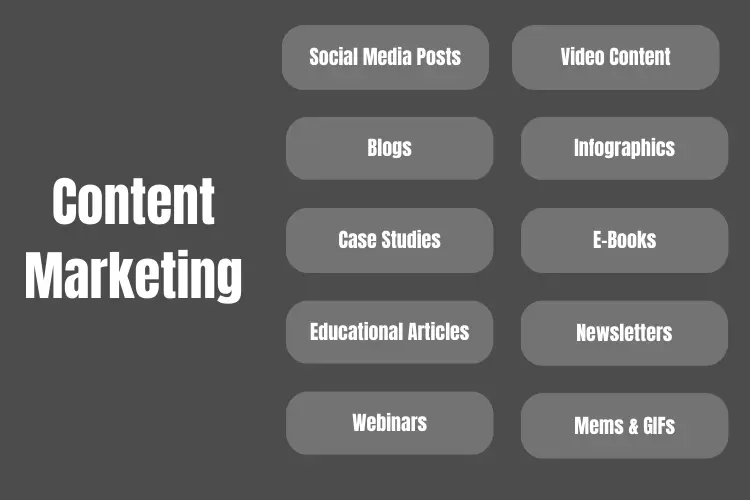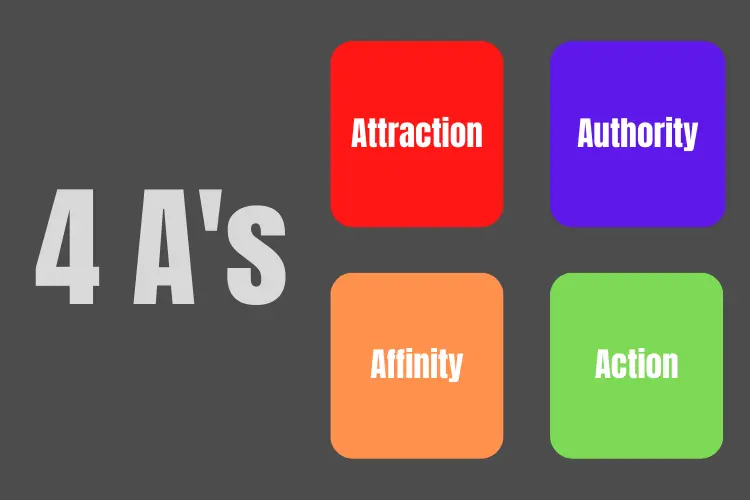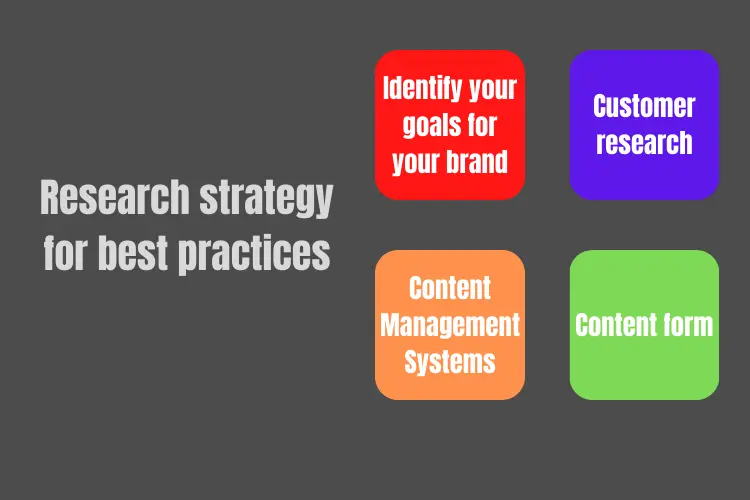Table of Contents
Intro
When it comes to developing a brand, one thing will never change: your target market will always look for a company they can believe in and one that can be relied upon to be genuine and provide authentic service. As a result, content marketing assists you in lifting your company to attract more readers by strategically targeting key demographics.
We're here to explain how to get the most out of content marketing with calculated stages and a powerful strategy that will multiply your efforts tenfold.
What does content mean and what is content marketing?

So what exactly is “content”? How do you market it?
Think of your brand or company as a box of Skittles, now turn it over and read the ingredient list--that’s your content, the stuff that makes your Skittles have flavor. Now, remember what they taught you in health class: whatever appears first on the ingredient list has the highest concentration--sugar, the ingredient that makes our content sweet and hits the right taste buds to make customers buy again and again! The sugar in our analogy is optimized content marketing.
Sugar is addictive and your content should be interesting enough to make the viewer keep viewing it!
Here is a clear cut content and content marketing definition:
Content can be anything from newsletters, blogs and articles, videos, carousel posts, and even podcasts. But you can’t just create content willy nilly--it should be relevant to what you’re trying to sell to your audience. Consequently, content marketing is a marketing approach that involves developing and publishing relevant articles, video content, blogs, and other material in order to entice, engage, and maintain an audience. This strategy develops competence, increases brand recognition, and keeps your company at the top of customers' minds.
Why is content marketing important?
.webp)
You might feel like we’re slapping you with a bunch of buzzwords with no end in sight. Save your confusion, we’ll explain exactly what you should care about content marketing; why is it so important?
Content marketing is crucial since it provides the answers to your audience's inquiries and aids in the development of connections, credibility, improved sales, and lead generation.
The world is saturated with media, and even you must admit that you spend a bit longer than you'd prefer on Tik Tok and Instagram (don’t worry, us too). As soon as posts begin to repeat themselves or become less fascinating than when you originally refreshed the screen, you can also admit that you close the app. Customers now demand constant, high-quality content to keep them engaged or else, they abandon the brand.
Content marketing strategy will make users spend more time on your website, giving you more traffic and higher visibility on search engines. Optimized blogs suited for your niche audience will also give you authority over your industry—consumers will see you as an expert and will go back for more content once they have another inquiry. The most beneficial of course is your brand will grow. Traffic towards your website will increase traffic to your other platforms like Instagram, YouTube, and other social media. You’ll gain a ton of followers and build authenticity through your new found reputation.
How content marketing works
Are you excited? We’re excited! We’re thrilled to be the one’s to tell you just how content marketing works!
We’ll explain with another analogy: you are Romeo and think of your customer as Juliet…it’s love at first sight but the County Paris, Juliet’s intended and her parents (your business competitors trying to snatch Juliet away from you) are angry! Paris wants Juliet all for himself and not you and her parents are doing all that they can to make her stay! So what do you do? The real Romeo would go into a frenzy and take poison but you’re smarter than that--you need to wow Juliet and win her over! How? Flowers? A puppy? Serenade, maybe?
Serenade, yes! You’ll write a song filled with words that speak to Juliet’s heart!
Get it?
Customers need more than service listings and products to keep them engaged with your brand’s website. Your blogs, articles, and posts should be interesting and relevant to your service to make customers fall in love with your company as a whole and not just treat you like a one-stop shop.
Did you know 88% of people owe brand content for their purchase of a product? You can see how important it is to implement content marketing. If you’re still short on ideas, read on to find out how to get started on SEO copywriting and article writing!
How to get started with content marketing
To get started you should understand the content marketing basics:
1) The four A’s: Knowing the components of content creation
The four A’s will help you remember how to keep your content at its peak: attraction, authority, affinity, and action.

- Attraction: Content that is interesting enough to be shared. This content is free and uses keywords to gain organic traffic.
- Authority: This type of content demonstrates your expertise on a subject related to your industry because after all, how else will people trust you?
- Affinity: Affinity content represents what you wish to promote as a brand. It inspires and shows your relatability to consumers.
- Action: Content that is written to call customers to well, take action. It must be written with an intended goal and compelling enough to entice a reader.
2) Researching strategy for best practices

Before you can begin creating content you need a good strategy. You can’t just go start advertising your products without having a goal in mind. Yes, it’s an ego stroke to see your name on a billboard in bright colors but, some marketing strategies work more than others for different industries. Going back to the makeup example, you’ll benefit from posting about makeup products, writing articles about trendy eyeshadow styles, and discussing beauty hacks. For a tech company, you need to show your expertise in all things software and may even benefit from writing guides for newbies. Consequently, content varies. But the method to formulating a strategy for best practices stays the same:
- Identifying your goals for your brand: What kind of audience do you want to reach? How do you wish to come across to customers?
- Customer research: What do your customers like? What kind of topics do they tend to click on? What do they steer clear from?
- Content management systems: A content management system (CMS) is a software used to organize content that enables numerous authors to generate, update, and post. Without a content management software, you would have to create a dynamic HTML file. You could simply type your content on an interface using a content management system which is a lot less complicated than trudging through hours of code. WordPress, Magento, and Umbraco are just a few examples. On these platforms, you can employ the greatest SEO techniques and analytics to increase traffic and learn more about your customers.
- Content form: What kind of content do you wish to create? How often will you deliver it?
3) Create written content relevant towards brand identity and customer persona
Written content marketing is a great way to get started on your brand-building journey. Written content includes anything from blogs, articles, newsletters, and even text on a post. But make sure that the written content you create doesn’t venture off from your brand. If you’re all about makeup, then stick to topics related to the beauty industry, and avoid venturing off into topics related to clothes and shoes. If you’re unsure about what to write, research your market. Ask: what are my clients searching for? What interests them? Research any trends related to your business and popular topics of discussion.
The two main types of written content are divided into copywriting and content writing.
Copywriting and content writing sound similar but in fact, they’re entirely different but both offer their own unique benefits. Knowing the difference and when to use each strategy can help you discover a smarter way to carry out brand promotion.
Here’s a quick chart to help you identify and remember the difference between both:
Copywriting vs. Content writing
Written Content Marketing | What is it? | Benefits |
Copywriting | Copywriting’s goal is to sell. It includes sales pages, landing pages, emails, website copy and ads. It is short form and focuses on persuading readers to take action. Effective copywriting boosts product sales. | Copywriting enables you to easily and immediately interact with a variety of customers. It assists you in producing compelling content that aids in achieving the sales objective. |
Content Writing | Content writing is used to inform, entertain or educate readers i.e interesting blogs and articles. This is long-form content using advanced SEO practices. | Content writing helps build brand awareness and boosts your SEO. You can stand out from your competition by making quality content shared by customers. |
What is SEO content writing?

You might have seen the word “SEO” floating around previously. SEO is a critical part of content writing.
SEO is an acronym for search engine optimization. It is a method of enhancing the information on your website to make it more visible when people look up terms and topics associated with your brand. Because you can't buy search engine traffic, SEO is crucial. You must put in the effort. Every year, people conduct trillions of searches, with the desire to locate goods and services being the main driver. You should be aware of the best practices because the search engine is a major source of traffic.
Posting useful and authoritative material, as we've already discussed, using alt tags, and finding keywords related to your content that will drive visitors to your website are a few approaches to rank your website. The easiest thing for newbies to manage is probably keywords. A page's title, URL, meta-description, and content should all contain relevant keywords. However, you shouldn't stuff your page with keywords. They must be watched over and made to appear natural on your page. Additionally, keywords may be connected to any search query and presented at the bottom of your website as FAQs. There are numerous applications for SEO; all you need to do is keep up with the most recent developments.
Best SEO practices
1. Implement more long-tail keyword integration: Rather than using one-phrase keywords, use those will longer sentences. For example, if you are writing a piece on washing clothes don’t just use the phrase “washing clothes” you can get more hits by stating “How to wash clothes properly.”
2. Use more white Space: Your website needs to look appealing so don’t fill it up with words that cannot only look unattractive but be overwhelming for readers with short attention spans. Use white space and break up texts with images and sections.
3. Use an optimized title tag and meta description: The title should make it known to consumers who you are and what you provide along with where. The meta description should use call-to-action phrases and highlight your expertise.
4. Try earning a backlink: A backlink is when another site uses your content to link information. Wikipedia does this all the time where the majority of their pages are linking to other users. Making informational content using stats and educational data is a great way to get other sites to link you, deeming you reputable.
Stages of content writing
Now that you have become an expert on all things related to contact marketing, are you going to teach you about the stages of contact grading and you can have a more effective approach to harnessing an audience?
1) Strategy
You must have a strategy in place before you start writing. List the primary competitors you will be up against as well as the target audience you hope to achieve. Here, you may decide how to differentiate yourself while still being pertinent to the client. Focus on a topic that relates to the objectives of your website. Try writing about the advantages of a new product you've just released.
The best content writing strategy uses funnelling. Although it may sound funny, the journey a visitor takes to become a client is described by this crucial concept in the digital marketing industry. The funnel's apex begins with awareness, and its bottom always ends in action. Similar to how water initially flows through a funnel before pouring directly into a container, the liquid makes a dip through the little funnel to determine how it will flow.

Awareness
The top of the funnel is where you will establish the topic's relevancy and promote your branding. You should keep users interested in order to increase your awareness. To get referral traffic from search engines, you might add blog material that is search-engine friendly. Become keyword-focused to increase the number of leads.
Interest
To generate interest in customers you should be educating them, engaging them on how they can benefit from consuming the content or your product, and notifying them about any other free services you provide like newsletters, social media pages, discounts, etc.
Desire
Once you’ve generated interest within the client toward your product, you need to hone their desire to purchase. Bad marketing lets sales fall right before a client and you can take action. Intrigue your client further by driving them towards the finish line!
Action
The bottom of the funnel is action. This is where all your prospective clients turn to leads and become interested in your services. To make the most out of the bottom of the funnel and to drive the maximum action, inspire your visitors and leave them wanting more with personalized attention.
2) Writing
Now we get to the writing itself. You shouldn't be writing about subjects that are so obscure that nobody will look for them. Instead, look for hot themes that you can personalize with your own originality and unique touch while still being relevant to your brand. To keep the reader interested, this could entail including comedy or personal anecdotes as well as making references to other types of media. Your blog post or other written content should be both interesting and educational. The customer will benefit most from your content and feel like they have something in common with you that goes beyond business.
3) Optimization and Publishing
Before publishing, you should check that your content complies with SEO after you've finished writing. Make sure your content is readable and contains relevant keywords without sounding artificial or overused. Additionally, including FAQs and a summary paragraph at the conclusion of your blog post can help it become more visible in search engine results. Remove any excess or difficult language that doesn't make sense or isn't required. To break up the text and make it look more fascinating, you may also use pictures and GIFs.
Pro tip: The quantity of competitors in your market, the size of your audience, and even the domain authority of your own website all affect the choice of keywords. Only go for keywords that have a high search volume.
4) Promotion
There are several ways to advertise content, but social media is by far the most popular. Promotion serves more purposes than merely increasing readership; it may also result in additional backlinks, which are worth their salt in the SEO market.
Conclusion
Now you’re ready to take on content marketing since you’ve read our guide and have become an expert! Remember the best brands who maintain relevancy do well to serve the consumer. Your marketing plan should be catered towards your audience. Although that means you’ll need to be patient and we mean, really patient, and put in a lot of effort, the work will pay off and your brand will get the recognition it deserves.
| We’ve summed it up for you to make it easy: |
|

.webp)
Lisa R.Hanger